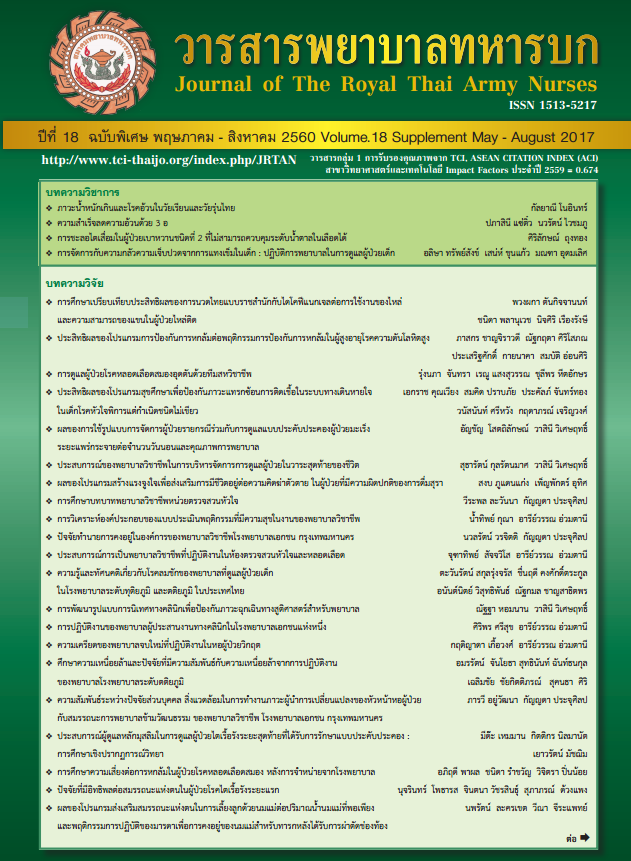การศึกษาเปรียบเทียบประสิทธิผลของการนวดไทยแบบราชสำนักกับไดโคฟีแนกเจลต่อการใช้งานของไหล่และความสามารถของแขนในผู้ป่วยไหล่ติด
Keywords:
นวดไทยแบบราชสำนัก, ไหล่ติด, การใช้งานของไหล่, ความสามารถของแขน, ไดโคฟิแนกเจล, court-type traditional Thai massage, frozen shoulder, function assessment, ability of arm, diclofenac gelAbstract
การวิจัยเรื่องนี้มีวัตถุประสงค์ เพื่อศึกษาเปรียบเทียบผลของการนวดไทยแบบราชสำนักกับไดโคฟีแนกเจล ต่อการใช้งานของไหล่และความสามารถของแขนในผู้ป่วยไหล่ติด รูปแบบการวิจัยเชิงทดลองทางคลินิก เลือกประชากรโดยการสุ่มจำนวน 60 คนแบ่งเป็นกลุ่มทดลอง 30 คน กลุ่มควบคุม 30 คน กลุ่มทดลองรักษาโดยการนวดแบบราชสำนักสัปดาห์ละ 2 ครั้งติดต่อกัน 6 สัปดาห์กลุ่มควบคุมรักษาโดยการทาไดโคฟิแนกเจล ทาครั้งละ 5 กรัม 3 ครั้งต่อวัน ติดต่อกัน 6 สัปดาห์ ติดตามผลทั้งสองกลุ่มสัปดาห์ที่ 8 และ 10 ประเมินผลการรักษาโดยแบบประเมินความสามารถของแขนในการทำกิจกรรม (DASH) แบบประเมินการทำงานของไหล่(Function of shoulder) ก่อนและหลังการทดลอง ผลการทดลองพบว่า ทั้งด้านการใช้งานของไหล่และความสามารถของแขนก่อนและหลังการทดลองภายในกลุ่มของทั้งกลุ่มทดลองและกลุ่มควบคุมมีความแตกต่างกันอย่างมีนัยสำคัญทางสถิติ (p < 0.0001) แต่เมื่อเปรียบเทียบระหว่างกลุ่มพบว่ามีความแตกต่างแต่ไม่มีนัยสำคัญทางสถิติ สรุปได้ว่าการนวดไทยแบบราชสำนักและไดโคฟิแนกเจลต่างก็ให้ผลดีในการรักษาไหล่ติด เห็นได้จากผลของระดับการใช้งานของไหล่และความสามารถของแขนในการทำกิจกรรมในผู้ป่วยไหล่ติดได้ผลดีขึ้นเหมือนกัน
A Comparative Study of Court-Type Traditional Thai Massage Versus Diclofenac Gel on Function of Shoulder and Ability of Arm in Patients with Frozen Shoulder: A Randomized, Controlled Trial
The objectives was to determine the effectiveness of court-type traditional Thai massage (CTTM) and diclofenac gel (DG) on function of shoulder and ability of arm in patients with frozen shoulder. The study design was a randomized, single-blind. Sixty woman with frozen shoulder were recruits. Subjects were randomly assigned to receive CTTM (treatment group, n = 30) and DG (control group, n = 30). CTTM was performed for 12 sessions during a 1–6 week period, with followed up at week 8th, 10th. DG was administered 5 g three times a day for 6 weeks, and followed up at week 8th, 10th. Subjects were assessed function of shoulder and ability of arm at initial and week 10th by visual analog scale (VAS) and Disabilities of the Arm, Shoulder and Hand (DASH) respectively. The results within group comparison were showed that DASH and VAS score significantly decreases after treatment (p < 0.0001). In addition, the scores between CTTM and DG groups after treatment were not significantly different. Both CTTM and DG were capable to heal frozen shoulder and demonstrated a positive effect on arm’s ability and function of shoulder.
Downloads
Downloads
How to Cite
Issue
Section
License
บทความหรือข้อคิดเห็นใดใดที่ปรากฏในวารสารพยาบาลทหารบกเป็นวรรณกรรมของผู้เขียน ซึ่งบรรณาธิการหรือสมาคมพยาบาลทหารบก ไม่จำเป็นต้องเห็นด้วย
บทความที่ได้รับการตีพิมพ์เป็นลิขสิทธิ์ของวารสารพยาบาลทหารบก
The ideas and opinions expressed in the Journal of The Royal Thai Army Nurses are those of the authors and not necessarily those
of the editor or Royal Thai Army Nurses Association.






